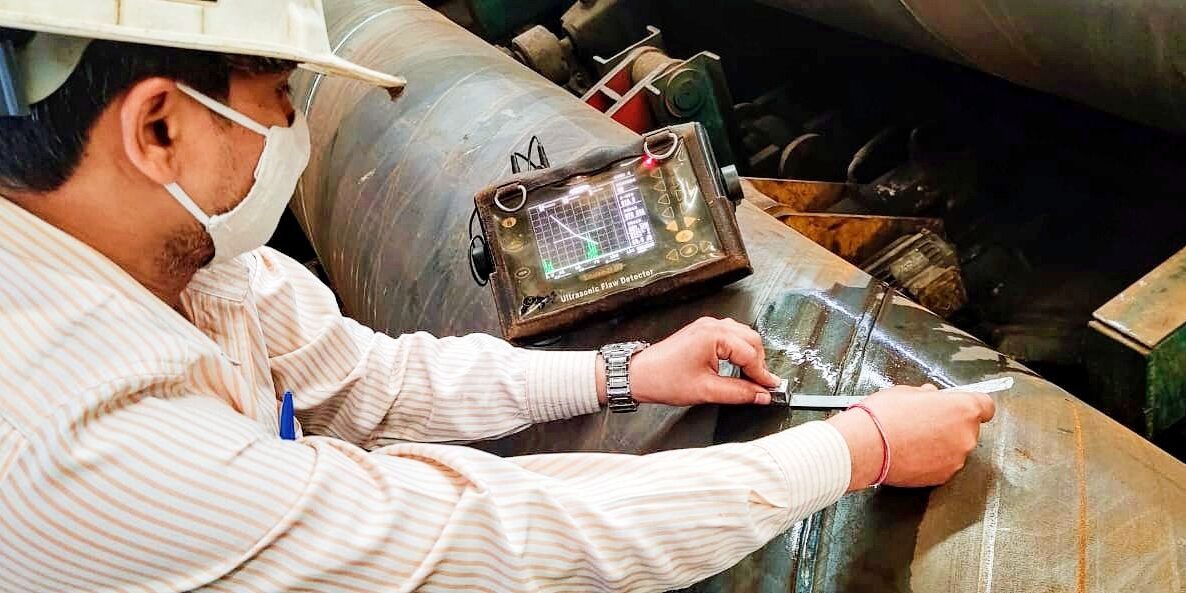Digital ultrasonic flaw detectors are modern age portable and processor-based flaw detectors. They are made up of parts including an ultrasonic transducer, hardware & software for capturing signals and analysing them, a data logging module, and a waveform display for viewing the images and graphs. The returning ultrasonic signals are processed digitally through these instruments for getting correct and precise results.
Flaws in structures compromise their integrity which may result in failures like crakes, leakage, corrosion, reduced performance, and disintegration. Undetected flaws pose a far greater risk to certain industries like automotive, aerospace, oil & gas exploration and transportation, power generation, and structures like bridges and towers. Other than these ships, reactors, pressure vessels, manufacturing, and a wide range of sectors also use ultrasonic flaw detection equipment to check for structural and integral flaws. This is critical to ensure the safety of the structures as well as for human life and the protection of the environment.
Types of Flaws Detected
Ultrasonic flaw detectors are used to detect a wide range of flaws, voids, and inclusions. These include cracks (whether surface or subsurface), corrosions, oxidation, weld bond defects, erosion & abrasion, forging and casting flaws, grinding damage, wire & rope flaws, forming & rolling mill flaws, piping & tubing flaws, composite or honeycomb delamination and adhesive or sealant debonding among others.
Why Use Ultrasonic Flaw Detectors Over Other NDT Methods
Digital ultrasonic flaw detectors are one of the many NDT (Nondestructive Testing) techniques and equipment. Some NDT techniques include visual inspection (VT), Electromagnetic or eddy current (ET), computed tomography (CT) or digital imaging, x-ray or radiographic testing (RT), liquid penetrant (LP), magnetic particle testing (MT), and hardness testing (HD) among others.
Ultrasonic flaw detection has an edge over the others as it can inspect metal and alloys along with electrically insulating or non-ferromagnetic materials. It is also used to inspect non-conductive materials like plastics, composites, ceramics, and wooden objects and structures. Ultrasonic flaw detectors along with their core ability of flaw detection can also gauge the elastic modulus, material thickness, speed of sound in the material, and leak detection.
How Do Digital Ultrasonic Flaw Detectors Work?
Ultrasonic flaw detectors generate ultrasonic sound waves through a pulser-receiver which are then sent to an ultrasonic transducer. Ultrasonic transducers propagate the high-frequency sound through the material or object being tested. The waves strike the voids, cracks, and other flaws, and the resultant echo is read by the transducers and other pick-up sensors and receivers. Digital flaw detectors use analog-to-digital converters also called digitizers along with signal amplifiers and filters to process the signals. These components reduce noise, improve signal detection thus leading to precise interpretation of flaw detection as well the flaw depth, its size, and its imaging. It is calculated through the time taken by the echo to return to the medium and the speed of the sound within the material.
Types of Ultrasonic Flaw Detection Techniques
Let us look at different types of ultrasonic flaw detection methods.
1. Straight Beam Ultrasonic Flaw Detection
Straight beam ultrasonic flaw detection use delay line, contact, dual-element, or immersion transducers. Using this method one can find delamination and cracks that are parallel to the surface of the object being tested. They are also useful in detecting porosity and voids in the material being tested.
2. Angle Beam Ultrasonic Flaw Detection
Angle beam ultrasonic flaw detection use angel beam or wedge transducers to detect faults. These are mostly used for weld inspection in detecting flaws throughout the welded area depths.
3. Phased Array Ultrasonic Flaw Detection
Phased array ultrasonic flaw detection use an array of several transducers that are placed in different positions. The cracks, welds, and defects can easily be imaged in this method. It is user-friendly and data is easily interpreted by presenting the cross-sectional images of internal structures in the form of color graphics.
4. Electromagnetic Acoustic Resonance Flaw Detection
These types of flaw detection use a non-contact EMAT transducer to propagate the signal which is interpreted through resonant acoustic analysis. These are used on conductive materials. The ultrasonic signals are sent by generating a magneto-restrictive or eddy current effect. This signal produces a pure resonant response. These digital ultrasonic flaw detectors are functional at high temperatures, can detect flaws on materials coated with paints, scales, or heavy oxide layers, and can be used for testing small diameter pipes. Since these are no-contact and require no couplant they are used to inspect moving materials during production. The vibrations from the neighbouring ring or surrounding machinery do not affect the transmission and reception of ultrasonic signals in any way.
Conclusion
Digital ultrasonic flaw detectors are used in different industries and sectors for inspecting flaws. These devices can detect minute flaws due to their high sensitivity and have deep detection ability. These flaw detectors also have greater accuracy than other NDT equipment procedures, particularly for detecting internal flaws and the thickness of parallel surfaces. Ultrasonic flaw detectors are used to correctly and quickly pinpoint the shape, size, orientation, and nature of defects so that quick decisions are made. Modsonic is the manufacturer of high-quality ultrasonic flaw detector equipment in India. They offer a wide range of ultrasonic testing and flaw detection equipment including a number of Conventional, Imaging, and Multichannel devices.







